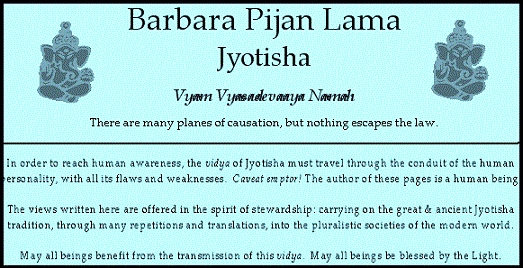
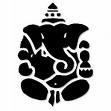
Annotated
Bibliography
of
Jyotishavidya
Educational Texts
Some suggestions for
the aspiring Western Jyotiṣika
this page in Progress!
As a student and teacher of Jyotisha in the West, iappreciate that the late"Esoteric Astrology" 1925-2005 Jyotishi Bepin Behari (and his USA publishers) have provided an accessible, affordable, and easy-to-use English-language guide to basic planetary placement interpretation. Planets in the Signs and Houses is accessible to any beginning student or teacher of beginners.
Bepin Behari. (2003). Fundamentals of Vedic Astrology: Vedic Astrologer's Handbook, Volume One. Lotus Press: Twin Lakes, wI.
Like its companion volume, Planets in Signs and Houses (2003), this book is a well-organized, portable reference guide to Jyotisha basics. Nicely typeset with clear chapter headings. Assets for the learner include an extensive table of contents, index, glossary, and a variety of handy charts.
Introductory Topics in Part-1 and Part-2 = rashi (signs), bhava (houses), signs (rashi), yogas (combinations), naakshatra (lunar astrology), varga (divisional charts), Kalapurusha (the cosmic man, for medical astrology) and planetary friendships. Part-3 interpretation = more esoteric but still basic enough to guide beginners.
Because this list of topics would be covered in any introductory Jyotisha class, behari's "Fundamentals " makes a convenient textbook for a first class in Jyotishavidya or for self-learning.
Vedic Astrology Handbook 1 and Handbook 2. Intermediate students are directed to more comprehensive English texts such as Light on Life (1996) and Three Hundred Important Combinations (1947, 1983) and others.
The Nakshatra descriptions are scaled-down versions from"Myths and Symbols " (1990). These simplified versions = 3-4 paragraphs each, which seems just right for the beginner who is already overwhelmed with the complexity of Jyotisha terminology. Intermediate students can search Myths and Symbols for more depth. Behari's drishti patterns seem a bit exotic, especially for Rahu-Ketu (p 158-160).
If the beginner needs more background on planetary aspects (drishti) there is an introductory treatment of Parashari drishti in David Frawley's The Astrology of the Seers (1990).
Overall, aright-sized reference guide that is easy to buy and use for a class. Recommended to students and teachers who need an introductory English-language text for ready reference to basic Jyotisha concepts.
Bepin Behari. (2003). Planets in Signs and Houses : Vedic Astrologer's Handbook, Volume Two . Lotus Press: Twin Lakes, wI.
Great textbook for a first class in Jyotisha or for self-learning. Organized in an easy look-up, reference book format. English vocabulary is well chosen. Descriptions of the planetary placements are clear enough that the engaged reader can perceive the underlying relationship between the graha (planet) which occupies the rashi (sign) and the graha which owns the rashi. This fundamental relationship is crucial to all Jyotisha interpretation.
The reader who claims that the book (or its interpretations) is "flawed" may be reacting to a slightly fatalistic or judgmental tone in Behari's descriptions. It is true that the reader will need a moderate level of East-West intercultural competence to appreciate the rather somber writing style of men of Behari's generation. However, the descriptions are accurate and the tone, in the case of negative placements, is not unwarranted.
It is also true that studying one's own nativity, exclusively and in detail, is never a good way to learn Jyotisha. It is almost impossible to take an objective view of one's own self. The mature student of Jyotisha will do case-studies of numerous charts (friends, family, celebrities) about which the factual life details are well known. After comparative study, the student can determine whether Behari's placement descriptions are accurate across a range of objective samples. This method will avoid the type of personal reactivity expressed by the angry reader above.
As a student and teacher of Jyotisha in the West, iappreciate that the late Bepin Behari (and his USA publishers) have provided an accessible, affordable, and easy-to-use English-language guide to basic planetary placement interpretation. It would be recommended to start by reading Planets in the Signs and Houses which is written in plain language and accessible to beginning students. Also a helpful text for teacher of beginners.
Robert Svoboda. The Greatness of Saturn: A Therapeutic Myth
Manik Chand Jain. (1973). The Stars and Your Future.
This handy guidebook gives esoteric descriptions of each degree in the circle of 360. Very popular, and remarkably accurate for the navamsha lagna degree sometimes called point of Svamsha . Helpful tool for confirming degree qualities in rectification.
Many of Jain's popular books appear to have been heavily plagiarized, mainly from western sources, which has tarnished Jain's reputation in the West.It is clear that parts of the book = outright copies of Isidore Kozminsky's Zodiacal Symbology and Its Planetary Power (1917)
(see www.astroAmerica.com/v-jain.html for evidence )
Nevertheless this little book has marvelously useful supplemental utility, and highly recommended.
Intermediate-beginner
Valerie Roebuck. (2002). The Circle of Stars
David Frawley. The Astrology of the Seers
Robert Svoboda and Hart de Fouw. (2000). Light on Life: An Introduction to the Astrology of India
Robert Svoboda and Hart de Fouw. (2000). Light on Relationships: The Synastry of Indian Astrology
QUOTATION from Shil-Ponde. (1939). Hindu Astrology Joytisha-Sastra
Bepin and Madhuri Behari. Esoteric Principles of Vedic Astrology
Bepin Behari. Myths and Symbols of Vedic Astrology .
Similar to Behari's "Planets in Signs and Houses "and"Fundamentals of Vedic Astrology" , this semi-introductory Jyotisha text is a handy reference work for intermediate students of the vidya - with certain caveats.
Students of Jyotisha who are already educated in western astrology, and wanting to acquire proficiency in Jyotisha, may find Behari's descriptions too heavily laden with theosophical concepts, or simply too mystical. Even those who come to Jyotisha studies without western tradition background may find that Behari's theosophy overwhelms his astrology. Students unfamiliar with theosophical teachings may struggle to separate the classical Jyotisha information from his heavily embroidered cosmological context.
Having said that, the student will find value in owning one volume that fairly concisely explains the navagraha (nine planets), the twelve rashi (signs), and the twenty-seven Nakshatra (lunar mansions). Since there is very little Nakshatra literature available in English, behari's Nakshatra chapters, each a readable 2.5 pages, will be an important addition to the Jyotisha learner's library.
Other reference assets for learners include a detailed index (rare in Jyotisha books!) and glossary, as well as several large, appended tables. Overall, this volume is worth the purchase price. I used it to learn from, and now I teach from it. Recommended to intermediate-level students, who have already acquired basic Jyotisha terminology -- with the caution that Behari's theosophy and his astrology do need to be mentally separated, in order to make full use of the book.
-
Bepin Behari. Timing of Events
-
B.V. Raman. A Catechism of Astrology .
-
Dennis Harness. The Nakshatra
A brief introductory overview and reference for beginners. B. V. Raman 's "Nakshatra Compatibility Chart" on p. 132-133 = a very helpful tool for quick marriage compatibility assessments.
Handy reference guide to the 27 (with Abijit, 28) Nakshatra, or lunar mansions, used extensively in Jyotisha practice to find the specific character of the Earthen-Moon, and other lagna.
Jyotisha contains both solar and lunar astrological lineages. Nakshatra readings are from the older, lunar component. Westerners accustomed to tropical, solar-only astrology will find Nakshatra divisions perhaps a very new concept.
For a historical explanation of the merging of solar and lunar systems in Jyotisha, see Valerie Roebuck The Circle of Stars.
Harness' "Nakshatra" provides a nice way to dip one's baby toe into the rich and complex lunar-house system. It offers about 3 pages of description for each Nakshatra . 3 pages turns out to be perfect for beginner-level quick reference without detailed study.
Each 3-page description includes David Frawley's definition of the nakshtra's "shakti" or divine energy, the central stars in its astronomical constellation, ruling planet and ruling deities, animal symbol, and descriptive psychological profile. (Harness has a PhD in counseling psychology.) There is a brief but useful section on Nakshatra as a tool to establish relationship compatibility, and a note on kuja dosha. Good index too! (A great rarity in Jyotisha books...) At the end, there is an appendix containing 12 basic rashi profiles, which may be helpful for early beginners.
If you are starting from a Western astrological perspective and have never heard of Nakshatra, by all means buy this modest volume for your Jyotisha bookshelf. It is approachable and easy to read.
Seasoned practitioners of the Vidya may find the descriptive material rather superficial, to the point of sounding vapid. This is definitely not a scholarly text. Considering the complexity of Nakshatra lore, it is not even particularly informative.
However, there is one advanced feature that experienced Jyotiṣika may agree re-pays the cost of this book. That is Harness' by-permission copy of B.V. Raman's incredibly convenient Nakshatra marriage compatibility chart, listed on p. 132-133. If one does frequent compatibility assessments, this chart can be a time-saver.
Despite its limitations or perhaps because of them, Nakshatra offers good value to its intended audience of early beginner students of Jyotisha. Harness has done a service by packaging the tip of the iceberg in a pleasant, accessible style.
Many students and teachers of Jyotishavidya in the West greatly appreciate that the late Bepin Behari (and his USA publishers) have provided an accessible, affordable, and easy-to-use English-language guide to basic planetary placement interpretation. It would be recommended Planets in the Signs and Houses to beginning students or teacher of beginners.
Essential Classical Jyotisha Reference Works
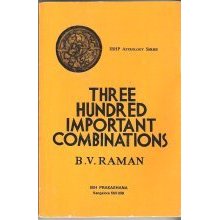 Three Hundred Important Combinations
by Jyotisha 1912-1998
B. V. Raman
Three Hundred Important Combinations
by Jyotisha 1912-1998
B. V. Raman
Jaimini Sutram
Jaimini Upadesha Sutram
Mantreswara's PHALA DEEPIKa
Saravali
Hora Sara of Varaha Mihira
Bhrigu Sutram
Brihat Parashara Hora-Shastra
Brihat Jataka of Varaha Mihira
Jataka Parijata
Most Authoritative Jyotisha Books?
BV RAMAN's answer
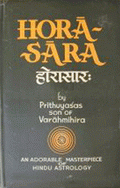
QUOTATION from B.V. Raman, A Catechism of Astrology. p. 21
" Q. 25:
of all the books Brihat Jataka, parashara Hora, Jataka Parijata, sarawartha Chinthamani , and Phala Deepika , which is the most authentic and which should be given preference?
Ans:
Parashara Hora is by far the most authoritative.
The other works are not by Rishis, but by experts in Astrology who were also gifted persons.
Each work is valuable in its own way, as are different text-books on the same subject, but more readily accessible to us and more easy of interpretation, and, in that sense, more useful to us.
Of all the; text-books mentioned, Brihat Jataka is considered more useful from the student's point of view."
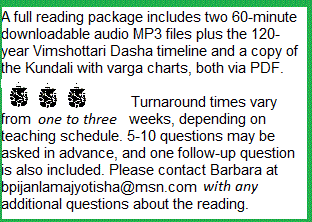
[How Readings Work] = [Sample Sacred Jewels Ratna Recommendation] = [Seva]
updated: 30 November 2025
 Copyright © 1994-2024 by Barbara Pijan Lama
Copyright © 1994-2024 by Barbara Pijan Lama
[Contact] = [How to Request a Jyotishavidya Reading]
Barbara Pijan Lama Jyotishavidya Vedic Astrology Surya Sun Chandra Moon Mangala Mars Budha Mercury Guru Jupiter Shukra Venus Shani Saturn Rahu Ketu Graha Planets Dasha Timeline Calendar Nakshatra Navamsha Marriage Children Treasury Career Spiritual Wisdom Cycles of re-Death and re-Birth
The information on barbarapijan.com , including all readings and reports, is provided for educational purposes only. Wishing you every happiness and continuing success in studies!

all that is true, all that is noble,
all that is just and pure,
all that is loveable and gracious,
whatever is excellent and admirable -
fill all your thoughts with these things."
~~ Paul of Tarsus, Epistle to the Philippians 4:8